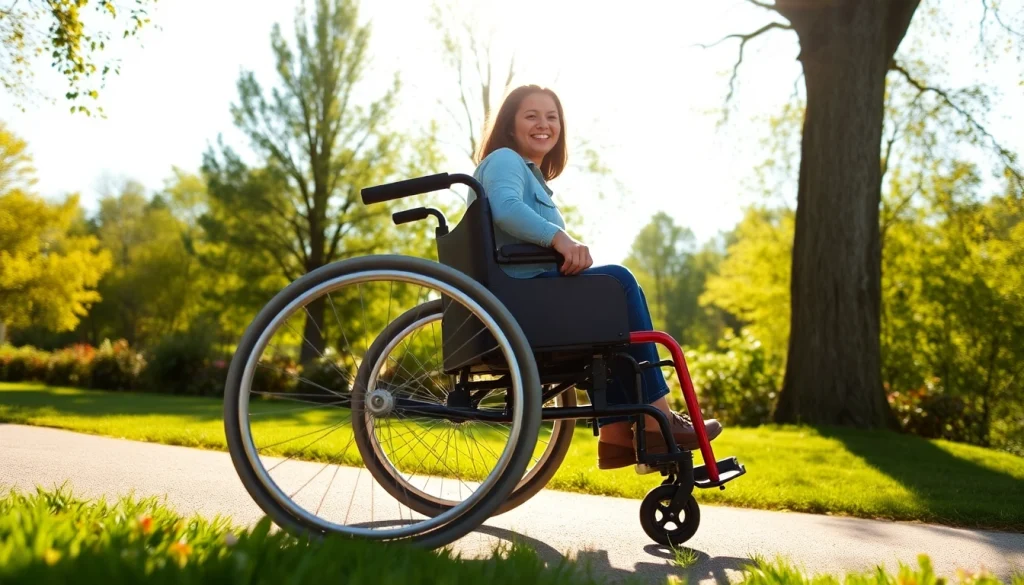
Understanding Manual Wheelchairs
Manual wheelchairs offer a versatile solution for individuals with mobility challenges, providing a way to navigate their environment with independence and ease. Unlike power wheelchairs, which rely on batteries and motors, manual wheelchairs require physical effort from the user, making their design and features essential for both comfort and functionality. In this comprehensive guide, we will explore the key components of manual wheelchairs, their benefits, and how they compare to powered options. For more insights on manual wheelchairs, check out Manual wheelchair resources available on TK Care.
Key Components and Features
Understanding the main components of a manual wheelchair helps users make informed choices tailored to their specific needs. The essential features include:
- Chassis: This forms the frame of the wheelchair, typically made from lightweight materials such as aluminum or titanium, ensuring both durability and ease of transport.
- Wheels: Manual wheelchairs come with two large rear wheels for propulsion and two smaller front wheels for steering. The size and type of wheels can significantly impact maneuverability and ease of movement over various terrains.
- Seat: Comfort is key in a manual wheelchair. Seats are generally padded and supported by a breathable fabric to enhance user comfort during prolonged use. Options for seat width and depth are available to accommodate different body sizes.
- Armrests: Adjustable or removable armrests provide additional support and comfort, allowing users to easily transfer in and out of the chair.
- Footrests: These are essential for leg support and can also be adjustable to cater to user preferences.
- Brakes: Most manual wheelchairs are equipped with handbrakes, which allow the user or caregiver to secure the chair, ensuring safety when stationary.
- Foldability: Many models are designed to fold for easy transport and storage, which is particularly useful for individuals who travel frequently.
Benefits of Choosing a Manual Wheelchair
Choosing a manual wheelchair comes with distinct advantages, making it an appealing option for many users:
- Cost-Effectiveness: Manual wheelchairs are generally more affordable than power wheelchairs. They require less maintenance and usually do not need costly batteries or electric components.
- Increased Physical Activity: Using a manual wheelchair demands upper body strength, providing users with an opportunity for exercise that can improve fitness and muscle tone.
- Maneuverability: Manual wheelchairs are often lighter and easier to maneuver in tight spaces, making them ideal for indoor use.
- Independence: For many, using a manual wheelchair fosters a sense of independence, as users can propel themselves without relying on power sources.
- Customization: Users can modify manual wheelchairs to meet their specific needs, tailoring aspects like seat height and wheel size for optimal comfort and performance.
Comparing Manual Wheelchairs to Power Options
When choosing a wheelchair, it’s important to consider the critical differences between manual and power wheelchairs:
- Accessibility: Manual wheelchairs can be navigated in environments with limited space where power wheelchairs might struggle.
- Energy Consumption: Manual wheelchairs do not require electricity, which can be advantageous in situations where charging options are limited.
- Weight and Portability: Manual wheelchairs are generally lighter, making them easier to lift and transport.
- Adaptability: Both wheeled options come with features catering to different user needs, but manual wheelchairs have a more streamlined structure.
Choosing the Right Manual Wheelchair
Choosing the correct manual wheelchair involves a thoughtful assessment of the user’s needs, preferences, and lifestyle. Here are essential factors to consider:
Assessing User Needs and Lifestyle
To select the right wheelchair, consider the following:
- Daily Activities: Think about where the wheelchair will primarily be used. For indoor use, compact models with smaller turning radii may be preferred, while outdoor users might prioritize durability and larger wheels.
- User Strength and Mobility: Assess the user’s physical ability to navigate a manual wheelchair. Users with greater upper body strength may prefer more active models, while those with limited strength might opt for lighter styles.
- Desired Accessories: Consider whether additional features, such as leg rests or storage bags, are needed for daily activities.
Size and Weight Considerations
The dimensions of a manual wheelchair are crucial for comfort and fit:
- Seat Width: A proper fit is important to prevent discomfort or pressure sores. Measure the user’s hip width and add about 2 inches for wiggle room.
- Seat Depth: Measure from the back of the hip to the back of the knee to get an accurate seat depth, ensuring the user’s posture is supported without hindering mobility.
- Weight of the Wheelchair: A lighter chair can make self-propelling easier, and should be manageable for both the user and caregivers.
Budgeting for Your Manual Wheelchair
When considering how much to spend on a manual wheelchair, it is essential to look at all costs:
- Initial Cost: Budget for the purchase price, which can vary significantly based on features.
- Long-Term Maintenance: Factor in potential costs for repairs, replacement parts, or accessories that may enhance usability.
- Insurance Coverage: Check if your health insurance covers any part of the wheelchair cost, as this can affect your overall budget.
Adjustments and Customizations
To enhance the comfort and utility of a manual wheelchair, considerations for adjustments and customizations are essential:
Common Adjustments for Comfort
Tailoring a manual wheelchair to user needs may involve several adjustments:
- Seat Height: Adjusting the height accommodates the user’s reach to the ground and overall comfort when transitioning in and out of the wheelchair.
- Armrest Height: Making armrests higher or lower helps users maintain a comfortable posture.
- Backrest Angle: Some models allow users to adjust the angle for optimal support during long periods of use.
Customizing for Individual Needs
Customization options can provide added benefits:
- Cushions: Specialized cushions can alleviate pressure and provide comfort while seated.
- Seat Belts and Safety Equipment: Adding straps and attachments can enhance safety for active users.
- Wheels and Tires: Swapping to larger wheels can improve performance outdoors, while puncture-resistant options can reduce maintenance.
Aftermarket Accessories to Enhance Functionality
There is a wide variety of accessories available to improve user experience:
- Storage Solutions: Backpacks or bags that securely attach to the wheelchair help organize essentials.
- Grab Handles: For caregivers needing to assist users, grab handles make transfers easier and safer.
- Portable Ramps: These make navigating curbs and steps manageable for users.
Best Practices for Using a Manual Wheelchair
Proper use of a manual wheelchair can enhance safety and functionality. Here are several best practices:
Techniques for Maneuvering in Different Environments
Maneuvering a manual wheelchair effectively depends on technique:
- Turning: Use wide arcs when turning to avoid tipping. Engage the footrests or wheels for better control.
- Managing Inclines: Lean forward on uphills and shift back when going downhill for balance and control.
- Overcoming Obstacles: Approach small bumps at an angle to prevent the front wheels from getting stuck.
Safety Tips for Manual Wheelchair Users
Safety is paramount for manual wheelchair users:
- Use of Brakes: Always engage brakes when stationary, especially on sloped surfaces.
- Avoid Dangerous Areas: Steer clear of surfaces that may be hazardous, like steep, icy, or uneven terrain.
- Awareness of Surroundings: Stay vigilant about the environment to avoid accidents caused by curbs, uneven walkways, or pedestrian traffic.
Maintaining Your Manual Wheelchair
Ongoing maintenance ensures the wheelchair remains in good condition:
- Regular Inspections: Check tires, brakes, and wheel alignment routinely to ensure safe operation.
- Cleaning: Keep the wheelchair clean and dry; a hose, soap, and water are helpful for upkeep. Pay special attention to the wheels and frame to prevent rust and corrosion.
- Replacing Parts: Don’t hesitate to replace worn tires or components for optimal performance.
Real-Life Experiences and Testimonials
Hearing from actual users can provide valuable insights into using manual wheelchairs:
Inspiring Stories from Manual Wheelchair Users
Real-life experiences often highlight how manual wheelchairs have positively impacted lives:
For example, one user shared how transitioning to a manual wheelchair allowed him greater independence and mobility in his daily life. He commented on how he could easily navigate crowded spaces and tightly-knit communities, emphasizing the chair’s lightweight structure and ease of use. Another user highlighted the sense of community and camaraderie that developed around shared experiences in manual mobility.
Community Support and Resources
Support systems enhanced the experience for many manual wheelchair users:
- Support Groups: Local and online groups provide opportunities for sharing experiences, resources, and advice.
- Resources for Accessibility: Various platforms offer information on accessible businesses, public transport options, and events tailored to wheelchair users.
- Advocacy Organizations: National and local organizations work toward improving mobility options and represent user interests in community planning discussions.
Future Innovations in Manual Wheelchair Design
The field of manual wheelchair design is evolving rapidly:
Recent innovations focus on incorporating smart technology with the promise of improving user experience. For instance, designs utilizing lightweight, durable materials are becoming more common, while ergonomic designs that consider user posture aim to enhance comfort during prolonged use.
Furthermore, customized aesthetics and personalization options have gained traction, allowing users to choose colors and designs that reflect their individuality. Future trends indicate a push toward even more personalization and adaptability, ensuring manual wheelchairs remain a practical, stylish choice for many individuals.






